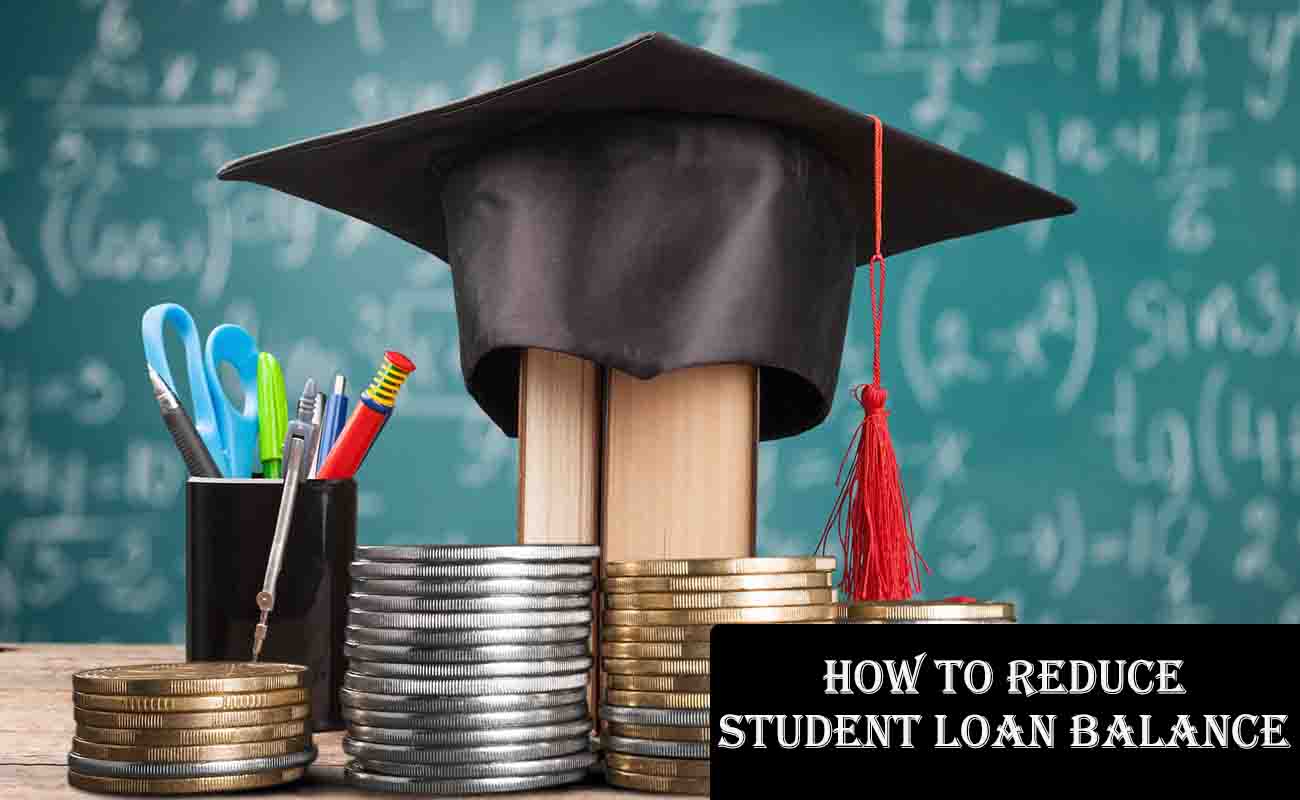In this post, I will show You How to Reduce Student Loan Balance. Reducing your student loan balance is a goal many borrowers share, and I’ve been there, staring at those numbers, wondering how to make them shrink. The good news is that with some planning, you can make real progress.

Below, I’ll share practical strategies to help you lower your student loan debt, explained in simple terms so you can take action today. Always check with your loan servicer or a financial advisor to ensure these options fit your situation, as loan terms and policies can vary.
As someone who’s wrestled with the weight of student loans, I know how it feels to see that balance linger longer than you’d like. Reducing your student loan balance isn’t just about throwing money at it, as it’s about smart strategies that fit your life.
In this detailed guide, I’ll walk you through proven methods to lower your student loan debt, using simple language and practical tips you can start using today. Whether you’re fresh out of college or years into repayment, these approaches can help you take control.
Let’s start with a quick foundation. Student loans come in two main flavors: federal and private. Federal loans, backed by the U.S. government, offer benefits like income-driven repayment plans and forgiveness programs.
Private loans, from banks or other lenders, often have higher interest rates and fewer protections but might be more flexible if you have strong credit. Knowing which type you have is the first step to picking the best strategy to reduce your balance. Now, let’s dive into the how-to.
Understanding Student Loans
Before we jump into the strategies, let’s clarify what you’re dealing with. Federal student loans include Direct Subsidized Loans, Direct Unsubsidized Loans, Direct PLUS Loans, and Direct Consolidation Loans. These loans come with perks like income-driven repayment (IDR) plans, which adjust your payments based on your income, and forgiveness programs like Public Service Loan Forgiveness (PSLF).
Private student loans, on the other hand, are based on your creditworthiness. They don’t offer the same flexibility or forgiveness options, but they might have competitive interest rates if your credit is solid.
Understanding the type of loan you have is crucial because it determines which options are available to you. You can check your federal loans at studentaid.gov and review private loans through your lender or a free credit report at annualcreditreport.com.
Strategies to Reduce Student Loan Balance
Here are the most effective ways to lower your student loan balance, with details to help you decide what works best for you.
1. Making Extra Payments
One of the most straightforward ways to reduce your student loan balance is to pay more than the minimum each month. By doing this, you chip away at the principal faster, which means less interest accrues over time. This is especially effective if you target the loan with the highest interest rate first—a strategy called the “debt avalanche.”
For example, if you have one loan at 6% interest and another at 8%, focus extra payments on the 8% loan while making minimum payments on the 6% loan. Once the higher-interest loan is paid off, redirect those funds to the next loan.
Even small extra payments, like $20 or $50 a month, can make a difference. For instance, paying an extra $50 a month on a $10,000 loan with a 6% interest rate could save you hundreds in interest and shorten your repayment timeline.
Contact your loan servicer to ensure extra payments are applied to the principal, not future payments, to maximize the impact. You can find your servicer’s contact info at studentaid.gov.
2. Income-Driven Repayment Plans
If you have federal student loans, income-driven repayment (IDR) plans can help manage your payments and potentially reduce your balance through forgiveness. These plans set your monthly payment based on your income and family size, sometimes as low as $0.
After 20 or 25 years (depending on the plan), any remaining balance is forgiven. The Saving on a Valuable Education (SAVE) plan, launched in 2023, is particularly helpful because it forgives unpaid interest if your payment doesn’t cover it, preventing your balance from growing.
To enroll in an IDR plan, you’ll need to recertify your income annually through your loan servicer or at studentaid.gov/idr. If your income drops or your family size increases, your payment could decrease further.
Be aware that extending your repayment period might increase the total interest you pay, but the lower payments and potential forgiveness can provide significant relief. Use the Loan Simulator at studentaid.gov/loan-simulator to compare plans and see what fits your budget.
| IDR Plan | Payment Basis | Forgiveness Timeline | Key Feature |
|---|---|---|---|
| SAVE | 10% of discretionary income | 20-25 years (based on loan amount) | Forgives unpaid interest |
| PAYE | 10% of discretionary income | 20 years | Cap payments at the standard plan |
| IBR | 10-15% of discretionary income | 20-25 years | Available for older loans |
| ICR | 20% of discretionary income | 25 years | The only option for Parent PLUS (after consolidation) |
3. Loan Forgiveness and Repayment Assistance Programs
Forgiveness programs can be a game-changer for reducing your student loan balance, especially for federal loans. The most well-known is Public Service Loan Forgiveness (PSLF), which forgives the remaining balance on your Direct Loans after 120 qualifying payments (about 10 years) while working full-time for a qualifying employer, like a government agency or nonprofit.
Payments must be on time, full payments under an eligible repayment plan, such as an IDR plan. As of July 2025, efforts are underway to strengthen PSLF, so check studentaid.gov/pslf for updates.
Other programs include:
- Teacher Loan Forgiveness: Up to $17,500 for teachers who work five consecutive years in a low-income school.
- Perkins Loan Cancellation: Forgiveness for certain public service roles, like teaching or nursing.
- Military Benefits: Interest rate caps at 6% under the Servicemembers Civil Relief Act, with potential 0% rates in hostile areas.
Some employers also offer student loan repayment assistance as a benefit, contributing directly to your loans. This is increasingly common, so ask your employer or explore job opportunities that include this perk. For more forgiveness options, visit studentaid.gov/pay-for-college/student-loan-forgiveness.
4. Refinancing
Refinancing involves taking out a new loan with a private lender to pay off your existing student loans, ideally at a lower interest rate. This can reduce your monthly payments or the total interest you pay, helping you lower your balance faster. For example, federal loan rates in 2025 range from 6.53% to 9.08%, while private lenders might offer rates as low as 4.5% for borrowers with excellent credit.
However, refinancing federal loans into private ones means losing access to federal benefits like IDR plans, deferment, forbearance, and forgiveness programs. This is a significant trade-off, so only refinance if you’re confident you won’t need these options. Private loans, on the other hand, are often good candidates for refinancing, especially if you can secure a lower rate.
To qualify, you typically need a credit score of 650 or higher, a steady income (around $20,000/year minimum), and a debt-to-income ratio below 36%. Some lenders allow a cosigner to improve your chances.
Use a refinancing calculator, like the one at bankrate.com, to estimate savings. Always compare multiple lenders and prequalify to check rates without impacting your credit score.
| Pros of Refinancing | Cons of Refinancing |
|---|---|
| Lower interest rate (e.g., 4.5% vs. 6.53%) | Loss of federal benefits (IDR, forgiveness) |
| Lower monthly payments with longer terms | Requires excellent credit for the best rates |
| Consolidates multiple loans into one | Needs steady income and a low debt-to-income ratio |
5. Other Tips to Reduce Your Balance
- Use Your Tax Refund: Applying your tax refund directly to your loan can reduce your balance without disrupting your monthly budget. Part of your refund might come from the student loan interest deduction, which allows you to deduct up to $2,500 of interest paid annually, depending on your income. Learn more at studentaid.gov/resources/tax-benefits.
- Set Up Autopay: Enrolling in automatic payments often comes with a 0.25% interest rate discount and ensures you never miss a payment, avoiding late fees. Contact your servicer to set this up.
- Avoid Deferment and Forbearance: While these options pause payments, interest continues to accrue, increasing your balance. If you need relief, an IDR plan is usually a better choice to keep your balance in check.
- Pay During Grace Periods: For federal loans, making payments during the grace period (typically six months after graduation) or while in school can prevent interest from capitalizing, keeping your balance lower.
FAQs
Q: What is the difference between federal and private student loans?
A: Federal loans, offered by the government, include benefits like income-driven repayment and forgiveness programs. Private loans, from banks or lenders, often have higher interest rates and fewer protections but may offer competitive terms for those with good credit.
Q: How do income-driven repayment plans work?
A: IDR plans base your monthly payment on your income and family size, sometimes as low as $0. After 20-25 years, the remaining balance is forgiven. The SAVE plan also forgives unpaid interest to prevent balance growth.
Q: Am I eligible for Public Service Loan Forgiveness?
A: You’re eligible for PSLF if you have Direct Loans, work full-time for a qualifying employer (government or nonprofit), and make 120 qualifying payments under an eligible repayment plan.
Q: What are the risks of refinancing federal student loans?
A: Refinancing federal loans into private ones means losing access to IDR plans, deferment, forbearance, and forgiveness programs. Weigh these benefits against potential interest savings.
Q: How can I make extra payments effectively?
A: Apply extra payments to the loan with the highest interest rate first to minimize total interest. Confirm with your servicer that payments go toward the principal.
Q: Are there any tax benefits for student loan borrowers?
A: Yes, you can deduct up to $2,500 of student loan interest paid annually on your taxes, depending on your income and filing status.
Conclusion
Reducing your student loan balance is a journey, but with the right strategies, you can make meaningful progress. Whether it’s making extra payments, enrolling in an IDR plan, pursuing forgiveness, or carefully considering refinancing, each step brings you closer to financial freedom.
Small actions, like using your tax refund or setting up autopay, can also add up. Stay proactive, check your options regularly, and don’t hesitate to contact your loan servicer for personalized guidance.
